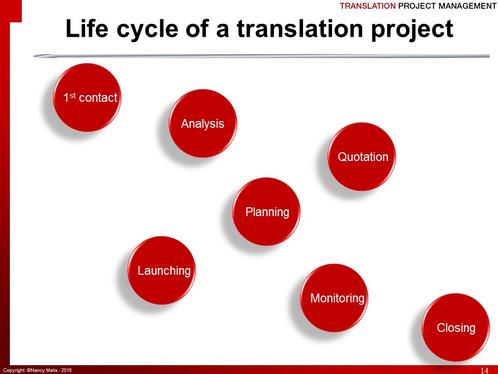
Related video on YouTube.
When I introduce students to Translation Project Management, I usually display an illustration showing the main steps involved in a translation project:

Regardless of the project length and the person in charge – the translation project manager, the translator or any other project participant –, it will include most of these steps, even if the sequence sometimes varies slightly. I’ll now briefly describe each step.
First contact
At the root of any translation project lies the primary contact between the requestor – either a prospective or an existing client – and a translation provider. The key point at this stage is to make sure that all translation requirements are crystal clear. The project manager or the translator has to grasp who his contact is, how much he knows about translation and which points should be clarified to pave the way for seamless collaboration in the future. Brand new contacts generally pose more of a challenge, but confusion can also arise when several requestors behave differently within the same client company or translation agency.
Analysis
Based on the project scope the client describes or on actual files, translation providers have to analyze the new or updated project. At this stage, they will identify the project type (software, documentation, website, multimedia, etc.), its possible components covering one or several domains (a marketing brochure coupled with a product license), the units to be handled (words, pages, illustrations, etc.), the production tasks to plan (translation, revision, DTP, testing, etc.) and the resources to put in place, both material (IT requirements, reference material, training, etc.) and human (various project participants).
Failing to correctly analyze a project could cause many issues throughout the entire project lifecycle, and this is true whether you are project managing, translating, revising or working on any other part of the process. Some might not plan enough time for their own tasks or forget to budget, or even worse, miss out some important project components.
Quotation
Once the project scope has been analyzed properly, service providers count the number of units related to the various tasks and refer to a price grid to issue a quotation.
Specific agreements might allow the project manager or translation team to launch the translation process without receiving the client’s approval of the budget first. This might happen if the project is urgent, or the client trusts the agency or freelancer(s) as a result of their long relationship and simply waits until the end of the project to be informed about the total cost.
Translators might also skip the quotation step, for instance when working for a translation agency that sends them purchase orders indicating how much they will be paid for the job. Nevertheless, they should always verify the accuracy of the POs they receive to make sure they reflect the correct rates and volumes.
Planning
Thorough assessment of all aspects of the project is crucial to guarantee punctual delivery. Project managers have to calculate the number of working days needed for each production stage, check the availability of the required resources and, if applicable, overlap some tasks to meet the imposed deadline or propose a reasonable delivery date.
Translators, and all other participants, should know what they are capable of producing per day based on project requirements, and evaluate whether they can deliver on time. Stress could ensue when several projects are ordered in parallel, all with very tight deadlines. In these cases, it might be helpful to set up a multi-project schedule, so that you can easily visualize if you can handle all the requests at the same time.
Launching
Some translation projects can be launched immediately without any extra preparation. Others, on the contrary, only start a few days after the client’s approval if they involve specific file formats, glossary creation, translation memory updates or even the setup of a new team if the project came as a surprise, or was so delayed that all the human resources initially booked had been assigned to other projects.
Before diving into any job, translators should ensure that the reference material they need is available, their tools are appropriate for the specific project, etc. When working for a translation agency, they should never hesitate to point out anything that is missing to complete the job satisfactorily.
Monitoring
Failing to monitor projects is always dangerous for a project manager, especially when they involve several participants working on different components and translation into a number of target languages. One catastrophic consequence could be that, on the delivery day, one of the translators claims he never received the source files. Clear project tracking together with a well-organized project structure are key assets for all project managers. Asking for confirmation emails, closely supervising project participants, checking whether they have any questions or even requiring partial deliveries, will help the PM ensure the whole project runs smoothly and avoid any nasty surprises at the end.
When dealing with several projects in parallel or one project comprising many files, translators might find it useful to follow their own progress with a tracking sheet listing all the project items.
The financial aspect also requires monitoring throughout the project. Any additional work the client requests, rectifying of mistakes, or purchase of extra resources (software, hardware, books…), etc., might have a significant impact on the budget. It’s important, therefore, to keep an eye on any possible changes to the project scope that would require budget adjustments.
People working in production should also track the time they spend on the project, for instance using timesheets. It might help them to be aware of their profitability on certain types of project, precautious they should take in future, and maybe new training they should undertake.
Closing
Delivering a translation project is not always merely a matter of sending a file via email. You might also have to run a last check before delivery, double-check that all instructions have been followed, use a special media for delivering the project, rename the target files, send to people other than the initial requestor, etc. Moreover, the delivery of the target files does not necessarily mean that the project is fully finished. The client might send some feedback, a post-mortem could be requested, or, after a while, some archiving might become essential. Invoicing and profit calculation will also be part of this last step.
Each step of a translation project has to be carefully managed to minimize the risks and guarantee success, as a project manager, as a translator or as any project participant. Omitting one or several of those aspects might jeopardize a client relationship, and in extreme cases, the whole business.
Nancy Matis, May 2015
